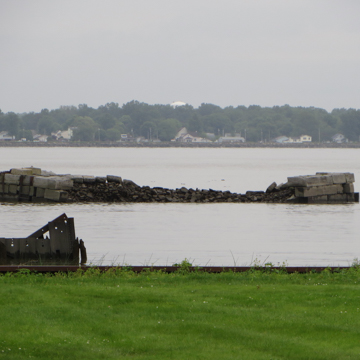Ice floes could crush wooden-hulled ships, so piers were built to form a barrier sheltering New Castle harbor. These were the first constructed anywhere on the Delaware River. An initial set of three was funded by state lottery and installed in 1795 and 1801. An act of Congress in 1802 appropriated $30,000 for many more Delaware River piers, provided the sites were ceded to the federal government. The Latrobe-Mills survey of 1805 shows four “U.S. Piers,” results of the first nonmilitary federal funding applied to the Delaware. Further piers were added later, until the ascendancy of iron-hulled ships rendered them unnecessary. Today there are seven in all. The two oldest, square in plan, lie at the foot of Harmony Street and along the silted-up shoreline at Alexander's Alley. The five hexagonal-plan piers, left to right as seen from shore, respectively date to 1874, 1879, 1882, 1875, and 1854 (the last now linked to shore by a walkway). The piers are rubble-cored with ashlar granite blocks outside, resting on wooden cribwork (visible at low tide). Some granite mooring posts and iron straps survive. The Ice Piers were a precursor to a much larger project at Lewes (ES25).
You are here
Ice Piers
If SAH Archipedia has been useful to you, please consider supporting it.
SAH Archipedia tells the story of the United States through its buildings, landscapes, and cities. This freely available resource empowers the public with authoritative knowledge that deepens their understanding and appreciation of the built environment. But the Society of Architectural Historians, which created SAH Archipedia with University of Virginia Press, needs your support to maintain the high-caliber research, writing, photography, cartography, editing, design, and programming that make SAH Archipedia a trusted online resource available to all who value the history of place, heritage tourism, and learning.


